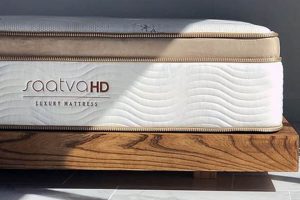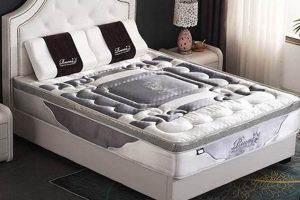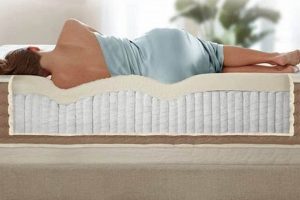Selecting an appropriate sleep surface is crucial for individuals carrying extra weight. The support and construction features of a mattress can significantly impact spinal alignment, pressure point relief, and overall sleep quality. A poorly chosen mattress may lead to discomfort, pain, and disrupted sleep, negatively affecting health and well-being.
The right sleep solution offers enhanced durability, preventing premature sagging and maintaining consistent support over time. It also provides better temperature regulation, crucial for comfort as individuals with higher body mass tend to experience increased body heat. Historically, finding adequate sleep surfaces has been a challenge, but advancements in mattress technology have created more options designed to meet these specific needs.
Therefore, this article will delve into key features to consider when selecting a mattress, including construction materials, firmness levels, and specific design elements that promote comfortable and restful sleep for individuals requiring enhanced support.
Selecting a Supportive Mattress
Choosing a suitable mattress is paramount for individuals requiring enhanced support. The following recommendations offer guidance in identifying a product that promotes optimal sleep health.
Tip 1: Prioritize Innerspring or Hybrid Models: Mattresses incorporating coil systems generally offer greater support and durability compared to all-foam alternatives. The coil gauge influences firmness and stability; a lower gauge typically indicates a firmer, more supportive core.
Tip 2: Consider High-Density Foam: If foam layers are present, ensure they are composed of high-density materials. High-density foam resists compression and prevents premature sagging, contributing to the longevity of the mattress.
Tip 3: Evaluate Edge Support: Reinforced edges provide a stable perimeter, preventing roll-off and maximizing the usable sleep surface. This is particularly beneficial for individuals who utilize the full width of the mattress.
Tip 4: Select an Appropriate Firmness Level: While personal preference plays a role, individuals requiring enhanced support often benefit from a firmer mattress. A medium-firm to firm surface can promote spinal alignment and reduce pressure points.
Tip 5: Assess Weight Capacity: Verify the manufacturer’s stated weight capacity to ensure the mattress is designed to withstand the intended load. Exceeding the weight limit can compromise support and shorten the lifespan of the product.
Tip 6: Explore Cooling Technologies: Overheating can disrupt sleep. Look for mattresses incorporating cooling gels, breathable fabrics, or open-cell foam to regulate temperature and enhance comfort.
Tip 7: Read Reviews and Seek Professional Advice: Consult user reviews and, if possible, seek recommendations from healthcare professionals or sleep specialists to gain insights into mattress performance and suitability.
Adhering to these guidelines can facilitate the selection of a mattress that promotes comfortable, restorative sleep and contributes to overall well-being. Prioritizing support, durability, and temperature regulation is essential for a positive sleep experience.
The subsequent sections will address specific mattress types and materials in greater detail, providing a comprehensive understanding of available options.
1. Reinforced Edge Support
Reinforced edge support is a critical feature in a mattress designed for individuals requiring additional support. It directly impacts the stability and usable surface area of the sleep environment, contributing significantly to overall comfort and longevity.
- Prevention of Edge Sagging
Reinforced edges prevent premature sagging, a common issue in mattresses lacking this feature. This is particularly crucial for individuals carrying extra weight, as the edges of the mattress are subjected to increased pressure when sitting or sleeping near the perimeter. Sagging edges reduce the usable sleep surface and can contribute to a feeling of instability.
- Enhanced Stability and Support
Reinforcement, often achieved through high-density foam encasements or additional coils along the perimeter, provides a more stable and supportive edge. This is especially beneficial for individuals who tend to sleep near the edge of the mattress or who require assistance when getting in and out of bed. The stable edge minimizes roll-off and ensures consistent support across the entire mattress surface.
- Maximizing Usable Sleep Surface
Without reinforced edges, the edges of a mattress can compress and slope downwards, effectively reducing the area available for comfortable sleep. Reinforced edges maintain a consistent, level surface, allowing individuals to fully utilize the mattress width. This is particularly important for couples or individuals who prefer to spread out during sleep.
- Increased Mattress Longevity
By preventing edge collapse, reinforced edge support contributes to the overall durability of the mattress. It distributes weight more evenly across the structure, reducing stress on individual components and prolonging the lifespan of the sleep surface. This translates to a better long-term investment and reduces the need for premature replacement.
In summary, reinforced edge support is an essential attribute for mattresses designed to accommodate individuals requiring extra support. It enhances stability, maximizes usable sleep surface, and extends the lifespan of the mattress, thereby promoting a more comfortable and restful sleep experience. The absence of this feature can compromise the mattress’s ability to provide adequate support and contribute to premature wear and tear, diminishing its suitability.
2. High Coil Count
A high coil count in an innerspring or hybrid mattress directly correlates with enhanced support and durability, factors of paramount importance for individuals who are overweight. The coil system serves as the primary support structure, and a greater number of coils generally translates to more effective weight distribution across the mattress surface. This even distribution minimizes pressure points and prevents localized sagging, maintaining spinal alignment and reducing the likelihood of discomfort during sleep. A low coil count, conversely, may lead to uneven support, accelerated wear, and a compromised sleep experience. In practical terms, a person of higher body mass will exert greater pressure on the mattress, making a robust coil system with a high count essential for maintaining the mattress’s integrity and providing consistent support over time. Examples of mattresses specifically designed for heavier individuals often emphasize a high
coil count as a key feature.
Furthermore, the type of coil system also plays a significant role. Pocketed coils, where each coil is individually wrapped, are particularly beneficial. This design allows each coil to respond independently to pressure, conforming more precisely to the body’s contours and minimizing motion transfer. For instance, consider two mattresses of similar construction, one with 400 interconnected coils and another with 800 individually pocketed coils. The latter will almost certainly provide superior support and pressure relief for a heavier individual, as the independent coils can more effectively adapt to the body’s unique shape and weight distribution. The higher coil count ensures that more coils are actively engaged in providing support, reducing stress on individual coils and prolonging the mattress’s lifespan.
In conclusion, a high coil count is a critical component of a mattress designed to provide adequate support and durability for individuals who are overweight. The enhanced weight distribution, pressure point relief, and prolonged lifespan afforded by a high coil count translate to a more comfortable and restorative sleep experience. While other factors, such as foam density and edge support, also contribute to overall mattress quality, the coil system remains the foundational support structure, and a high coil count is a reliable indicator of its ability to withstand the demands of a heavier sleeper. The challenges in finding a suitable mattress are often mitigated by prioritizing this key feature.
3. Density of Foam
Density of foam is a critical determinant of a mattress’s suitability for individuals requiring enhanced support. Foam density, measured in pounds per cubic foot (PCF), directly impacts the material’s ability to resist compression and maintain its shape over time. Higher density foam provides greater support, preventing premature sagging and ensuring consistent comfort, particularly under increased weight. Conversely, low-density foam compresses easily, leading to reduced support, discomfort, and a shorter mattress lifespan. A mattress constructed with high-density foam is therefore a foundational element in providing adequate support for those carrying extra weight.
The practical implications of selecting a mattress with appropriate foam density are significant. Consider a mattress with a comfort layer of 2.0 PCF density foam versus one with 4.0 PCF density foam. The former will likely compress significantly under the weight of an individual, resulting in diminished support and potential pressure point buildup. The latter, with its higher density, will distribute weight more evenly, providing better spinal alignment and reducing the risk of discomfort. Moreover, the higher density foam will be more resilient to wear and tear, extending the mattress’s useful life and representing a more cost-effective long-term investment. Memory foam and latex foam, two common materials used in mattresses, exhibit varying densities, and it is essential to prioritize higher densities within these material types for optimal support.
In summary, foam density is a key attribute to consider when selecting a mattress designed for individuals needing additional support. Prioritizing higher densities ensures better weight distribution, enhanced comfort, and prolonged mattress lifespan. Failing to consider this factor can lead to premature sagging, compromised support, and a less restful sleep experience. Therefore, understanding the relationship between foam density and mattress performance is crucial in making an informed decision. The challenge lies in discerning actual foam density, often requiring careful scrutiny of product specifications and potentially contacting the manufacturer directly to confirm these details.
4. Temperature regulation
Temperature regulation is a critical performance aspect in sleep surfaces, particularly impactful for individuals with a higher body mass index. Increased body mass tends to correlate with a greater propensity for experiencing elevated body temperature during sleep. This physiological reality necessitates that mattresses designed for these individuals possess enhanced capabilities for dissipating heat and maintaining a comfortable sleeping temperature.
Insufficient temperature regulation can disrupt sleep cycles, leading to restlessness and a reduction in overall sleep quality. This is because the body’s core temperature naturally decreases during sleep, a process facilitated by the sleeping environment. A mattress that traps heat impedes this natural cooling process, potentially triggering wakefulness or preventing the attainment of deeper, more restorative sleep stages. Materials such as open-cell foam, gel-infused memory foam, and breathable fabrics like Tencel are incorporated into mattresses to mitigate heat retention. For instance, a mattress utilizing a phase-change material can absorb and release heat, maintaining a more stable temperature throughout the night. The integration of ventilation channels within the mattress core can further enhance airflow, facilitating heat dissipation. Without these features, trapped body heat will significantly degrade the potential for quality sleep.
Therefore, effective temperature regulation represents a cornerstone of a sleep system designed to support overweight individuals. The selection of a mattress incorporating features that actively manage heat is essential for promoting uninterrupted, restorative sleep and maximizing overall well-being. Failure to address this critical factor can negate the benefits of other supportive mattress features, such as adequate spinal alignment and pressure relief.
5. Appropriate Firmness
Selecting an appropriate firmness level is paramount when choosing a mattress for individuals requiring enhanced support. Firmness directly influences spinal alignment, pressure distribution, and overall sleep comfort, making it a key consideration in optimizing sleep quality.
- Spinal Alignment
Maintaining proper spinal alignment during sleep is crucial for preventing back pain and promoting long-term musculoskeletal health. For individuals with a higher body mass, a mattress that is too soft can allow the spine to sink into an unnatural curvature, leading to strain and discomfort. Conversely, a mattress that is too firm may not conform sufficiently to the body’s contours, creating pressure points and disrupting sleep. An appropriate firmness level provides the necessary support to keep the spine aligned in a neutral position, regardless of sleeping position.
- Pressure Distribution
Effective pressure distribution is essential for preventing the development of pressure sores and minimizing discomfort during sleep. A mattress that concentrates pressure in certain areas, such as the hips and shoulders, can restrict blood flow and cause pain. An appropriate firmness level distributes weight evenly across the mattress surface, reducing pressure points and promoting circulation. This is particularly important for individuals who spend extended periods in bed or who have limited mobility.
- Sleeping Position Compatibility
Different sleeping positions require di
fferent levels of support. Side sleepers typically benefit from a slightly softer mattress that allows the shoulders and hips to sink in comfortably, while back sleepers generally require a firmer surface to maintain spinal alignment. Stomach sleepers often need the firmest support to prevent their midsection from sagging. An appropriate firmness level considers the individual’s preferred sleeping position and provides the necessary support to maintain spinal alignment in that position. - Personal Comfort Preference
While spinal alignment and pressure distribution are critical factors, personal comfort preference also plays a significant role in determining the appropriate firmness level. Some individuals simply prefer a softer or firmer mattress, regardless of their sleeping position or body type. Ultimately, the most appropriate firmness level is one that provides adequate support while also feeling comfortable and conducive to restful sleep. Trial periods and reviews can give the individual the opportunity to experience and adapt to their mattress firmness.
In conclusion, selecting an appropriate firmness level requires careful consideration of spinal alignment, pressure distribution, sleeping position, and personal comfort preference. A mattress that balances these factors provides the optimal combination of support and comfort, promoting restful sleep and long-term musculoskeletal health. This balance is crucial for achieving the benefits of a supportive sleep surface.
6. Weight Capacity
Weight capacity is a fundamental, often overlooked, specification that critically determines the suitability of a mattress, particularly when considering optimal sleep surfaces for individuals with higher body weights. Mattress weight capacity refers to the maximum weight a mattress can consistently support without compromising its structural integrity or affecting its ability to provide adequate support and comfort. Failure to adhere to these weight limitations can lead to premature sagging, uneven support, and a reduced lifespan for the mattress. Therefore, understanding and prioritizing weight capacity is crucial when selecting a mattress intended to deliver long-term support and comfort to individuals with a higher body mass index.
For example, a mattress with a stated weight capacity of 250 pounds may quickly degrade and lose its supportive properties when consistently subjected to a weight exceeding that limit. This degradation manifests in several ways: the mattress may sag in the center, resulting in spinal misalignment; the edges may become weak and collapse, reducing the usable sleep surface; and the internal components, such as coils or foam layers, may break down, compromising the mattress’s overall structural integrity. A more robust mattress, designed with a higher weight capacity of, say, 500 pounds, is engineered to withstand increased pressure, featuring reinforced support systems, higher density materials, and enhanced construction techniques. The difference in performance and durability between these two mattresses is significant. A high weight capacity mattress may also have special reinforced borders and high-density foams.
In conclusion, weight capacity forms an indispensable component of the ‘best mattress for overweight people.’ Ignoring this specification results in compromised support, decreased comfort, and a shortened lifespan for the sleep surface. Prioritizing mattresses with weight capacities that comfortably exceed the user’s weight ensures optimal performance, long-term durability, and a superior sleep experience. Consumers should always verify the manufacturer’s stated weight limit, keeping in mind that shared weight when coupled with a sleeping partner could cause the product to wear significantly faster. Therefore, choosing a product with an adequate weight capacity is a primary consideration.
7. Durability of Materials
The durability of materials constitutes a cornerstone in evaluating a mattress’s suitability, particularly for individuals requiring enhanced support. The relationship between material robustness and long-term performance is direct: higher quality, more durable materials withstand the increased stress and pressure exerted by greater body weight, maintaining structural integrity and support over an extended lifespan. Conversely, mattresses constructed with inferior or less durable components degrade more rapidly, leading to sagging, uneven support, and a premature need for replacement. For instance, a mattress utilizing low-density foam or a thin coil gauge will likely exhibit significant wear within a relatively short timeframe, failing to provide consistent support and potentially exacerbating discomfort or pain. The choice of mattress materials directly influences its ability to provide lasting support and maintain its original shape and comfort level.
Consider two mattresses constructed with ostensibly similar designs: one featuring high-density latex foam and tempered steel coils, and the other employing lower-density polyurethane foam and thinner, un-tempered coils. While both mattresses may initially feel similar, the long-term performance will diverge significantly. The former, with its durable components, will resist compression and maintain its shape, providing consistent support for years. The latter will likely begin to sag and lose its shape within months, compromising spinal alignment and comfort. Furthermore, features such as reinforced stitching and durable ticking contribute to the overall resilience of the mattress, preventing tears and wear along seams and surfaces. These material choices provide a direct effect on how long the mattress will provide the comfort level required to have a good sleep quality.
In summary, the durability of materials is an essential factor in selecting a sleep surface designed for individuals requiring enhanced support. Prioritizing mattresses constructed with high-quality, robust components ensures long-term performance, consistent support, and a more cost-effective investment. The understanding and diligent assessment of material durability mitigate the risk of premature mattress failure and contribute to a more comfortable and restful sleep experience. Therefore, scrutiny of the material specifications cannot be overstated.
Frequently Asked Questions
The following questions address common concerns and misconceptions regarding mattress selection for individuals who are overweight. The answers provided are intended to offer clarity and guidance in making informed decisions.
Question 1: Does a higher price necessarily equate to a better mattress for individuals requiring enhanced support?
Price alone is not a reliable indicator of suitability. While higher-priced mattresses may incorporate premium materials and advanced construction techniques, it is essential to evaluate specific features, such as coil count, foam density, and weight capacity, irrespective of cost.
Question 2: Are all-foam mattresses unsuitable for individuals who are overweight?
While innerspring and hybrid mattresses are generally recommended due to their superior support and durability, some high-density foam mattresses can provide adequate support for individuals who are overweight. The density of the foam is paramount; low-density foam is generally unsuitable.
Question 3: How frequently should a mattress designed for individua
ls requiring enhanced support be replaced?
The lifespan of a mattress depends on several factors, including the quality of materials, weight of the sleeper, and sleeping habits. However, a mattress exhibiting signs of sagging, uneven support, or diminished comfort should be replaced, typically within 7-10 years.
Question 4: Is a firm mattress always the best choice for individuals who are overweight?
While firmer mattresses generally provide better support, the ideal firmness level depends on individual preferences and sleeping position. A medium-firm mattress may be suitable for some, while others may prefer a firmer surface. It is important to consider spinal alignment and pressure point relief when selecting firmness.
Question 5: What role does a mattress foundation play in supporting individuals who are overweight?
A stable and supportive mattress foundation is crucial for distributing weight evenly and preventing premature sagging. A weak or inadequate foundation can compromise the performance and lifespan of even the most durable mattress. Slatted foundations should have closely spaced, sturdy slats.
Question 6: Can a mattress topper compensate for an unsupportive mattress for individuals who are overweight?
A mattress topper can provide temporary relief from discomfort, but it is not a substitute for a supportive mattress. A topper cannot correct underlying issues with the mattress’s construction or weight capacity. It is, at best, a short-term solution.
In summary, selecting an appropriate mattress requires careful consideration of specific features and individual needs. Price, while a factor, should not be the sole determinant. Prioritizing support, durability, and comfort ensures a restful sleep experience.
The subsequent sections will delve into specific mattress brands and models that are commonly recommended for individuals requiring enhanced support.
Conclusion
The selection of an optimal sleep surface represents a crucial investment in health and well-being, particularly for individuals seeking enhanced support. This exploration of the critical features inherent in a suitable sleep environment underscores the necessity of prioritizing coil count, foam density, edge support, temperature regulation, firmness, material durability and specifically, weight capacity. A failure to adequately address these key performance indicators can lead to compromised support, diminished comfort, and a significantly shortened lifespan of the chosen mattress.
Therefore, potential purchasers are strongly encouraged to conduct thorough research, meticulously evaluate product specifications, and, when possible, seek professional guidance to ensure that their mattress selection meets their specific needs and promotes long-term sleep health. The decision regarding a sleep surface warrants careful consideration, as it directly impacts physical comfort and overall quality of life.






![Top-Rated: Best Twin Size Air Mattress [Guide] Organic & Natural Mattress Buyer’s Guide: Non-Toxic Sleep Solutions Top-Rated: Best Twin Size Air Mattress [Guide] | Organic & Natural Mattress Buyer’s Guide: Non-Toxic Sleep Solutions](https://mattressworldpa.com/wp-content/uploads/2025/07/th-7636-300x200.jpg)
